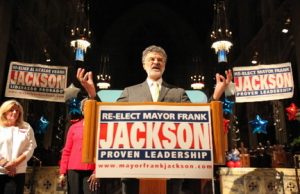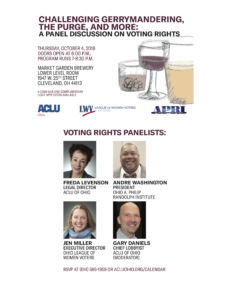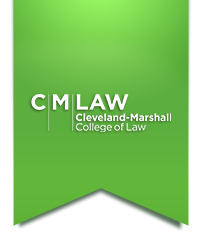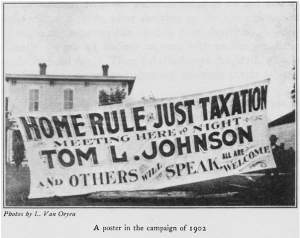Deadlock over Ohio House speakership could delay updating election equipment: Thomas Suddes (6/2/2018) Cleveland.com
The nation’s freshwater coast is a key fulcrum for Rust Belt revival (5/31/2018) Brookings Institute
50 most influential Clevelanders of all time (5/22/2018) Cleveland.com
Video from the “Women in Politics: How to get more women to run for office in Ohio” moderated by Mary Kilpatrick, Cleveland.com (5/16/2018)
The Browns Are Talking About a New Stadium… But here’s what they really want, and why it probably won’t happen (5/16/2018) Cleveland Scene
Forum looks to find answers on how to get more women involved in politics (5/14/2018) Cleveland.com
A wind farm on Lake Erie? If only Ohio pols, and some environmental activists, too, would get out of the way. (5/8/2018) Belt
It’s time for an economic development summit in Cleveland (4/28/2018) Smart Busiuness
Video from the Single Payer/Universal Healthcare forum (4/25/2018)
Could universal healthcare work in the U.S.? Panel discussion is Wednesday (4/20/2018) Plain Dealer
Roldo’s Point of View The legacy of a Cleveland hell-raiser (4/18/2018) Cleveland Scene
Interviews with 6 Ohio Governor Candidates. For May 8, 2018 primary (April, 2018)
Video from Shaker Library Levy forum from Shaker Democratic Club. Held on April 3, 2018
Lies, Damn Lies and the 450 Acres of Prime Real Estate That is Burke Lakefront Airport (4/4/2018) Cleveland Scene
Rev. Martin Luther King Jr.’s ties to Cleveland still strong 50 years after death (4/4/2018) Plain Dealer
Video from the “Redistricting in Ohio and US” forum (3/20/2018)
Recap story from “Redistricting in Ohio and US” forum (3/20/2018) Cleveland.com
Terminal Tower celebrated as “Cleveland’s Endearing Symbol” in CSU exhibit (3/18/2018) Plain Dealer
Inside Cleveland’s vacant Warner & Swasey factory, an industrial relic seeking new life (3/18/2018) Plain Dealer
Video from Shaker State of the City 2018 delivered by Mayor Earl Leiken (3/15/2018)
Cities Form Municipal Broadband Companies To Attract Companies and People (3/16/2018) Ideastream
Video from “Consumer Scams. How to spot avoid and respond” forum (3/8/2018)
Needed – a ballot issue to end the rule of guns in Ohio: Brent Larkin (3/8/2018) Cleveland.com
Video from “Opportunity Corridor forum moderated by Steven Litt, Plain Dealer (2/21/2018)
Rust and Renewal: A Cleveland Retrospective (2/2018) Cleveland Federal Reserve
Roldo Bartimole Marks 50 Years As Cleveland’s Watchdog Journalist (2/19/2018) Ideastream
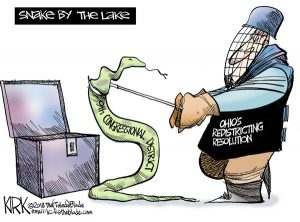
The infamous “Snake by the Lake” 9th Congressional District may have been put back in its box this week. Read more here (cartoon by Kirk Walters, Toledo Blade)
Woodmere and its connection to Northeast Ohio black history (2/16/2018) Cleveland.com
The Science Behind Balto’s Famous Journey That Took Place 93 Years Ago (2/15/2018) Inverse Science
Frank C. Cain, Cleveland Heights, and the Suburban Vision by Marian J. Morton (Feb 2018)
Ohio congressional redistricting deal a surprise victory for reform: editorial 2/6/2018 Cleveland.com
(After nearly 40 years) Dennis Kucinich’s City Hall portrait is ready (2/2/2018) Cleveland Magazine
Cleveland’s Ned Jordan ran an advertisement in 1923 that forever changed the automobile industry. It didn’t focus on price, engine size or features. It sold a feeling. (2/1/2018) Ohio Magazine
Cleveland Indians’ Chief Wahoo, from inception to end: A timeline (1/29/2018) Cleveland.com
Ohio’s very high-stakes, under-the-radar Senate race, explained (1/26/2018) Vox
“Is Northeast Ohio a Sanctuary Region? Where does our region stand on immigration?” (1/16/2018) video
Cleveland founder shares what his startup community gets right and wrong (1/9/2018) Venture Beat
What the Cuyahoga River Means to Cleveland (January) Cleveland Magazine

